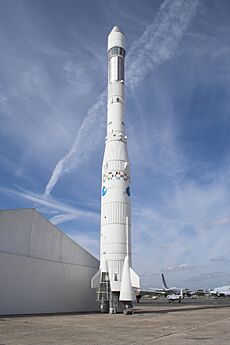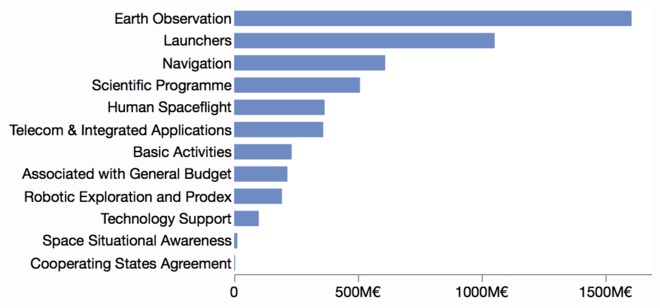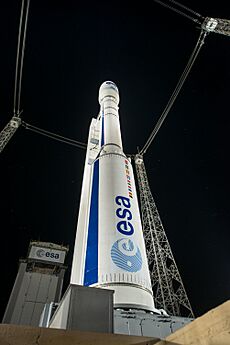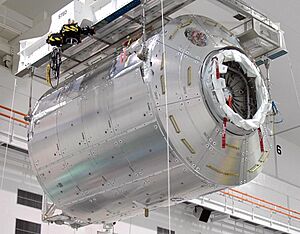European Space Agency facts for kids
|
Czech: Evropská kosmická agentura
Danish: Den Europæiske Rumorganisation German: Europäische Weltraumorganisation Estonian: Euroopa Kosmoseagentuur French: Agence spatiale européenne Finnish: Euroopan avaruusjärjestö Greek: Ευρωπαϊκός Οργανισμός Διαστήματος Hungarian: Európai Űrügynökség Irish: Gníomhaireacht Spáis na hEorpa Italian: Agenzia Spaziale Europea Luxembourgish: Europäesch Weltraumorganisatioun Dutch: Europese Ruimtevaartorganisatie Norwegian: Den europeiske romfartsorganisasjon Polish: Europejska Agencja Kosmiczna Portuguese: Agência Espacial Europeia Romanian: Agenția Spațială Europeană Romansh: Agenzia spaziala europeica Slovene: Evropska vesoljska agencija Spanish: Agencia Espacial Europea Swedish: Europeiska rymdorganisationen |
|
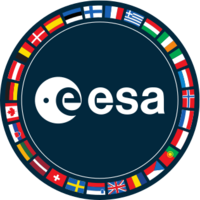 |
|

Logo
|
|
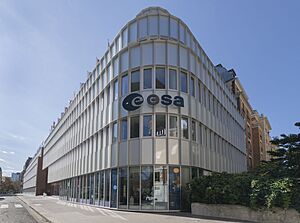
European Space Agency headquarters in Paris
|
|
| Agency overview | |
|---|---|
| Abbreviation |
|
| Formed | 30 May 1975 |
| Type | Space agency |
| Headquarters | Paris, France 48°50′54″N 02°18′15″E / 48.84833°N 2.30417°E |
| Official language | English, French and German (working languages) |
| Administrator | Josef Aschbacher (Director General of the European Space Agency) |
| Primary spaceport | Guiana Space Centre |
| Owners | |
| Employees | 2,547 (2023) |
| Annual budget | |
The European Space Agency (ESA) is a group of 23 countries working together to explore space. Its main office is in Paris, France. ESA was started in 1975 and has about 2,547 employees. In 2025, its yearly budget was about €7.7 billion.
ESA's work includes sending humans and robots into space. They help with the International Space Station and send missions to Mars and the Moon. They also study Jupiter, Mercury, and the Sun. ESA watches Earth from space, helps avoid asteroid impacts, and works on communication satellites. They design rockets and manage Europe's main space launch site in Kourou, French Guiana. Other important areas are space safety, satellite navigation, and finding new ways to use space technology.
ESA also works with Arianespace to operate the Ariane 6 rocket. They also team up with NASA to build parts for the Orion spacecraft, which flies on the Space Launch System.
History of ESA
How ESA Started
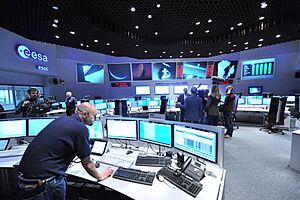
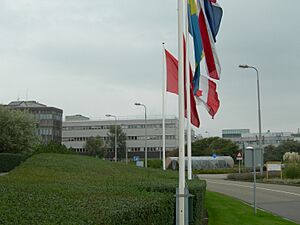
After World War II, many European scientists went to work in the United States. Even though Europe had money for research in the 1950s, scientists realized that single countries couldn't compete in space exploration. In 1958, two important scientists, Edoardo Amaldi from Italy and Pierre Auger from France, met to talk about starting a shared European space agency. Scientists from eight countries joined this meeting.
European nations decided to create two agencies. One was for building rockets, called ELDO. The other was for space research, called ESRO, which was the first version of ESA. ESRO started on March 20, 1964. Between 1968 and 1972, ESRO launched seven research satellites. However, ELDO struggled to build a working rocket. Both agencies faced problems with not enough money and different goals among their member countries.
The ESA we know today was formed in 1975. This happened when ESRO and ELDO joined together. Ten countries were founding members of ESA: Belgium, Denmark, France, West Germany, Italy, the Netherlands, Spain, Sweden, Switzerland, and the United Kingdom. They signed the ESA Convention in 1975. ESA launched its first big science mission, Cos-B, in 1975. This space probe studied gamma-ray emissions in the universe.
ESA's Later Achievements
ESA worked with NASA on the International Ultraviolet Explorer (IUE). This was the world's first high-orbit telescope, launched in 1978. It worked well for 18 years. Many successful Earth-orbit projects followed. In 1986, ESA started Giotto, its first mission into deep space. This mission studied comets like Halley. Later, ESA worked with NASA on missions like Hipparcos (a star-mapping mission), SOHO, Ulysses, and the Hubble Space Telescope. ESA also helped build the Huygens landing module for the Cassini–Huygens probe, which explored Titan, a moon of Saturn.
ESA also builds rockets to launch scientific tools and commercial satellites. The Ariane 1 rocket was launched in 1979. It carried mostly commercial satellites into orbit from 1984. The Ariane 4 rocket, which flew from 1988 to 2003, made ESA a world leader in commercial space launches in the 1990s. Its successor, Ariane 5, had a problem on its first flight. But it became very reliable, with 112 successful launches by 2023. The newest rocket, Ariane 6, had its first flight on July 9, 2024. Its first commercial launch was on March 6, 2025.
In the 2000s, ESA became a major player in space research. It joined agencies like NASA, JAXA, ISRO, the CSA, and Roscosmos. While ESA worked closely with NASA in earlier decades, it started to cooperate more with Russia. This was partly due to new rules on sharing information from the United States military. A 2011 statement said that Russia was ESA's first partner for long-term access to space. They had an agreement for peaceful space exploration.
Important ESA missions include SMART-1, which tested new space engine technology. The Mars Express and Venus Express missions explored those planets. ESA also played a big role in the ISS partnership. ESA continues its science projects, like Corot, launched in 2006, which helped search for exoplanets.
On January 21, 2019, ArianeGroup and Arianespace announced a contract with ESA. They would study how to mine the Moon for lunar soil, called regolith.
In 2021, ESA leaders agreed on the "Matosinhos manifesto." This plan set three main goals: "space for a green future," "quick and strong crisis response," and "protecting space assets." They also planned two exciting projects: bringing back samples from an icy moon and human space exploration. In the same year, ESA started looking for new astronauts for the 2022 European Space Agency Astronaut Group.
In the first half of 2023, ESA launched the Jupiter Icy Moons Explorer and the Euclid spacecraft. Euclid was built with the Euclid Consortium. It was designed to help scientists understand dark energy and dark matter by measuring how the universe is expanding.
ESA's most notable mission in 2024 was Hera (space mission). It launched on October 7, 2024. Hera will study the asteroid Dimorphos after NASA's Double Asteroid Redirection Test mission changed its path.
In early 2025, ESA released its Strategy 2040. This is a long-term plan for the agency's goals. It focuses on five key areas:
- Protecting Earth and its climate.
- Advancing space exploration.
- Making Europe stronger and more independent in space.
- Helping the economy grow and be more competitive.
- Inspiring future generations.
In March 2025, ESA started its European Launcher Challenge (ELC). This program aims to help Europe build its own rockets, starting with small ones. Eventually, it will lead to a new rocket after Ariane 6.
ESA Facilities
ESA's facilities are spread across different countries. Here are some of the most important ones:
- ESA Headquarters: Paris, France.
- ESTEC: In Noordwijk, Netherlands, where ESA's science missions are based.
- ESA Centre for Earth Observation: In Frascati, Italy, for Earth observation missions.
- ESOC: In Darmstadt, Germany, which controls ESA missions.
- European Astronaut Centre (EAC): In Cologne, Germany, where astronauts train.
- European Centre for Space Applications and Telecommunications (ECSAT): In Harwell, England, a research center.
- European Space Astronomy Centre (ESAC): In Villanueva de la Cañada, Madrid, Spain.
- European Space Security and Education Centre (ESEC): In Redu, Belgium.
- ESTRACK: ESA's network for tracking and communicating with spacecraft.
- Many other facilities work closely with ESA, like the Guiana Space Centre in Kourou, French Guiana, where rockets are launched.
ESA's Mission
The agreement that created ESA states its purpose:
The purpose of the Agency shall be to provide for and to promote, for exclusively peaceful purposes, cooperation among European States in space research and technology and their space applications, with a view to their being used for scientific purposes and for operational space applications systems…
ESA helps set a common space policy for Europe. It suggests space goals to member countries and tries to combine national space programs into one European program.
Jean-Jacques Dordain, who was ESA's Director General from 2003 to 2015, explained ESA's mission in 2003:
Today space activities have pursued the benefit of citizens, and citizens are asking for a better quality of life on Earth. They want greater security and economic wealth, but they also want to pursue their dreams, to increase their knowledge, and they want younger people to be attracted to the pursuit of science and technology.
I think that space can do all of this: it can produce a higher quality of life, better security, more economic wealth, and also fulfill our citizens' dreams and thirst for knowledge, and attract the young generation. This is the reason space exploration is an integral part of overall space activities. It has always been so, and it will be even more important in the future.
ESA Activities and Programmes
ESA describes its work in two ways: "Activities" for the public and "Programmes" for how budgets are organized. These can be either required or optional for member countries.
ESA Activities
According to ESA's website, its main activities are:
- Observing Earth from space.
- Human and Robotic Exploration.
- Launching rockets.
- Navigation (like GPS).
- Space Science.
- Space Engineering & Technology.
- Operations (controlling missions).
- Telecommunications & Integrated Applications.
- Preparing for the Future.
- Using Space for Climate.
ESA Programmes
- Horizon 2000
- Cosmic Vision
- Aurora
- Terrae Novae Programme
- Copernicus Programme
- Galileo
- Living Planet Programme
Required Programmes
Every member country must contribute to these programs. The European Space Agency Science Programme is a long-term plan for space science missions.
- Technology Development Element Programme
- Science Core Technology Programme
- General Study Programme
- European Component Initiative
Optional Programmes
Countries can choose to contribute to these programs. They become 'Participating States'.
- Launchers
- Earth Observation
- Human Spaceflight and Exploration
- Telecommunications
- Navigation
- Space Situational Awareness
- Technology
ESA Employment
As of 2023, ESA employs about 2,547 people directly. Many more work for contractors. New employees usually get a four-year contract. ESA offers benefits like childcare support and retirement plans.
ESA Members and Funding
Membership and Contributions
Member countries contribute different amounts to ESA's programs. Some programs are required, and others are optional. In 2008, required programs made up 25% of the budget, and optional programs were 75%. ESA has a policy called "georeturn." This means that the money member countries give to ESA is returned to companies in those countries through contracts.
By 2015, ESA had 22 member states. ESA's budget has grown over the years. In 2016, it was €5.25 billion. In 2024, it was €7.79 billion.
English and French are ESA's two official languages. Documents are also provided in German.
The table below shows the member states and their contributions in 2024:
| Member state or partner | Joined ESA | National space agency | Contributions (2024) | ||
|---|---|---|---|---|---|
| Million € | % of total | Per person (€) | |||
| Full member states | |||||
| 30 December 1986 | ALR | 62.4 | 1.2% | 6.85 | |
| 3 October 1978 | BELSPO | 292.6 | 5.6% | 24.91 | |
| 12 August 2008 | Ministry of Transport | 48.4 | 0.9% | 4.47 | |
| 15 September 1977 | UFM | 35.1 | 0.7% | 5.92 | |
| 1 September 2015 | ESO | 7.0 | 0.1% | 5.12 | |
| 1 January 1995 | TEM | 33.5 | 0.6% | 6.02 | |
| 30 October 1980 | CNES | 1,048.4 | 20.1% | 15.38 | |
| 26 July 1977 | DLR | 1,171.6 | 22.4% | 14.10 | |
| 9 March 2005 | HSC | 16.1 | 0.3% | 1.55 | |
| 4 November 2015 | HSO | 23.2 | 0.4% | 2.42 | |
| 10 December 1980 | Enterprise Ireland | 22.8 | 0.4% | 4.33 | |
| 20 February 1978 | ASI | 881.2 | 16.9% | 14.94 | |
| 30 June 2005 | LSA | 41.6 | 0.8% | 62.95 | |
| 6 February 1979 | NSO | 117.1 | 2.2% | 6.57 | |
| 30 December 1986 | NSA | 71.4 | 1.4% | 13.01 | |
| 19 November 2012 | POLSA | 47.7 | 0.9% | 1.30 | |
| 14 November 2000 | PT Space | 19.4 | 0.4% | 1.85 | |
| 22 December 2011 | ROSA | 51.0 | 1.0% | 2.68 | |
| 1 January 2025 | SPACE-SI | 3.9 | 0.1% | 1.84 | |
| 7 February 1979 | AEE | 297.5 | 5.7% | 6.19 | |
| 6 April 1976 | SNSA | 80.0 | 1.5% | 7.60 | |
| 19 November 1976 | SSO | 188.2 | 3.6% | 21.35 | |
| 28 March 1978 | UKSA | 448.9 | 8.6% | 6.60 | |
| Others | N/A | N/A | 203.2 | 3.9% | N/A |
| Non-full members | |||||
| 1 January 1979 | CSA | 11.0 | 0.2% | 0.28 | |
| 27 July 2020 | LSO | 0.5 | 0.0% | 0.27 | |
| 21 May 2021 | LSA | 0.9 | 0.0% | 0.32 | |
| 13 October 2022 | SSO | 3.5 | 0.1% | 0.65 | |
| Members and associates total | 5,024.9 | 64.5% | |||
| 28 May 2004 | EUSPA | 1,822.6 | 23.4% | 4.06 | |
| EUMETSAT | N/A | N/A | 116.4 | 1.5% | N/A |
| Other income | N/A | N/A | 821.2 | 10.5% | N/A |
| Other institutional partners and income total | 2,760.2 | 35.5% | |||
| Grand total | 7,785.1 | 100% | |||
Non-Full Member States
Some countries are not full members but work closely with ESA. As of January 2025, Latvia, Lithuania, Slovakia, and Canada are associate members. The European associate members might become full members in the future.
Latvia
Latvia became an associate member on June 30, 2020. This agreement was signed by ESA Director Jan Wörner and Latvia's Minister of Education and Science.
Lithuania
In May 2021, Lithuania became an associate member. This meant Lithuanian citizens could apply to the 2022 ESA Astronaut group. The application deadline was extended to give them a fair chance.
Slovakia
Slovakia became an associate member on October 13, 2022, for seven years. Before this, Slovakia had a "European Cooperating State" agreement with ESA since 2016.
Canada
Since January 1, 1979, Canada has had a special "Cooperating State" status with ESA. The Canadian Space Agency takes part in ESA's meetings and programs. Canadian companies can also get contracts to work on ESA projects. This agreement ensures that Canada gets a fair return on its investment. The latest agreement was signed in 2010 and lasted until 2020. In 2017, Canada increased its yearly contribution to €21.6 million.
ESA Budget and Funding
ESA gets its money from yearly contributions from its member governments. It also gets money from the European Union (EU). Every 3-4 years, ESA member states agree on a budget plan. This plan guides ESA's work for several years.
Countries often have their own space programs. These programs might work with ESA in different ways. For example, the French space agency CNES has a large budget. A part of this budget is given directly to ESA. Many space projects are joint efforts between national space agencies and ESA. ESA is not the only European government space organization. Others include the European Union Satellite Centre and the European Union Agency for the Space Programme.
Expanding ESA Membership
ESA has a process for European countries to join. It happens in three steps. First, a country signs a Cooperation Agreement. This means they have limited financial responsibilities. If a country wants to work more closely with ESA, it signs a European Cooperating State (ECS) Agreement. This allows companies in that country to bid for ESA contracts. The country can also join most ESA programs. Its financial contribution increases, but it's still less than a full member.
The ECS Agreement is usually followed by a "Plan For European Cooperating State" (PECS Charter). This is a 5-year program to help the country's space industry grow. After 5 years, the country can start talks to become a full member or an associate member. Many countries, especially those that joined the EU in 2004 and 2007, have started working with ESA.
| Applicant state | Cooperation agreement | ECS agreement | PECS charter | Association agreement signature | Associate membership | National space agency |
|---|---|---|---|---|---|---|
| 23 July 2009 | 19 March 2013 | 30 January 2015 | 30 June 2020 | 27 July 2020 | LSO | |
| 7 October 2010 | 7 October 2014 | 28 September 2015 | 28 April 2021 | 21 May 2021 | LSA | |
| 28 April 2010 | 16 February 2015 | 4 February 2016 | 14 June 2022 | 13 October 2022 | SSO | |
| 11 June 2014 | 8 April 2015 | 4 February 2016 | N/A | N/A | SRTI | |
| 27 August 2009 | 6 July 2016 | 24 April 2017 | N/A | N/A | through MoCW | |
| 19 February 2018 | 23 March 2023 | 16 August 2023 | N/A | N/A | through MoSE | |
| 20 February 2012 | 25 October 2023 | 12 September 2024 | N/A | N/A | MCST | |
| 15 July 2004 | N/A | N/A | N/A | N/A | TUA (agreement with TÜBİTAK UZAY) |
|
| 25 January 2008 | N/A | N/A | N/A | N/A | SSAU | |
| 30 January 2011 | N/A | N/A | N/A | N/A | ISA | |
| 14 February 2023 | N/A | N/A | N/A | N/A | AEM |
In December 2014, ESA ministers agreed to discuss future agreements with Israel, Australia, and South Africa. They saw good chances for working together.
A separate plan for space exploration calls for more cooperation with the United States, Russia, and China. This includes working on the ISS and developing ways to use space vehicles for exploration. It also involves robotic missions to the Moon and Mars, leading to a Mars Sample Return mission where Europe would be a full partner. Longer-term plans include human missions beyond Earth's orbit.
In August 2019, ESA and the Australian Space Agency agreed to explore deeper cooperation. They wanted to find projects in areas like deep space, communications, and mission support.
On November 17, 2020, ESA signed an agreement with the South African National Space Agency (SANSA). This built on earlier talks and strengthened their friendship.
ESA Launch Vehicles
ESA currently uses two main rockets: Vega-C and Ariane 6. Rocket launches are handled by Arianespace. This company is owned by the industries that build the Ariane 5 rocket and CNES. Launches happen at ESA's Guiana Space Centre in Kourou, French Guiana. Launching from near the equator allows rockets to carry heavier payloads into space. This is because the Earth's rotation gives an extra push at the equator.
Ariane 6 Rocket
The Ariane 6 is a powerful rocket designed to carry heavy loads. It had its first flight on July 9, 2024.
Vega-C Rocket
The Vega rocket is ESA's carrier for smaller satellites. Seven ESA member countries, led by Italy, developed it. It can carry satellites weighing between 300 and 1500 kg to an altitude of 700 km. This is good for low polar orbits. Its first launch from Kourou was on February 13, 2012. Vega started full commercial flights in December 2015.
The Vega rocket has three solid fuel stages and a liquid fuel upper stage called the AVUM. This upper stage helps place satellites precisely into orbit and can put multiple satellites into different orbits.
A larger version, Vega-C, had its first flight in July 2022. This new version has a bigger first stage, an improved second stage, and an upgraded upper stage. Vega-C can carry larger single satellites, multiple satellites, and perform more complex orbital maneuvers.
Funding for Ariane Rockets
Historically, Ariane rockets were mostly funded by ESA governments. These governments wanted to be part of the program. They expected to get about 90% of their investment back through contracts for companies in their countries. ESA is now changing this. They are moving towards competitive bids for building the Ariane 6 rocket.
Future Rocket Plans
Future projects include Prometheus, a reusable engine test. Phoebus is an upgraded second stage for Ariane 6. Themis is a project for a reusable first stage.
Human Space Flight
Astronauts and Missions
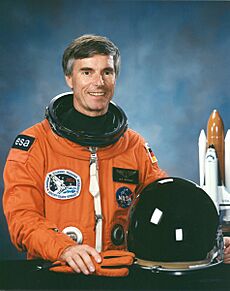
When ESA was formed, its main goal was not human space flight. It focused on uncrewed scientific exploration. The first non-Soviet European in space was not an ESA astronaut. It was Czechoslovak Vladimír Remek in 1978, on a Soviet Soyuz spacecraft. He was followed by others from Eastern Bloc countries. In 1982, Jean-Loup Chrétien became the first non-Communist Bloc astronaut to fly to the Soviet Salyut 7 space station.
Because Chrétien flew as a French astronaut, not an ESA astronaut, the German Ulf Merbold is considered the first ESA astronaut in space. He flew on the STS-9 Space Shuttle mission in 1983. This mission used the European-built Spacelab for the first time. STS-9 began a long partnership between ESA and NASA. Many ESA astronauts flew on Space Shuttle missions in the following years. Some Spacelab missions were fully funded and controlled by ESA. ESA also continued to work with the Soviet Union and later Russia, sending astronauts to the Mir space station.
By the late 1980s, European human space flights became more common. In 1990, the European Astronaut Centre was set up in Cologne, Germany. This center selects and trains astronauts. It also works with international partners, especially for the International Space Station. As of 2006, the ESA astronaut corps had twelve members.
In 2008, ESA started looking for new astronauts. Almost 10,000 people applied. After tests and interviews, six new astronauts were chosen in 2009.
Crew Vehicles
In the 1980s, France wanted Europe to have its own crew launch vehicle. A project called Hermes was started in 1987. It was a small reusable spaceship designed to carry 3 to 5 astronauts. It would have launched on the Ariane 5 rocket. Hermes was planned only for flights in low Earth orbit. The planning phase ended in 1991. The project was canceled in 1995 after about $3 billion was spent. This was because the political situation changed, and ESA looked to work with Russia.
In the 21st century, ESA started new projects for its own crew vehicles. One notable project is Hopper. Its prototype, called Phoenix, has been tested. While projects like Hopper are not ready yet, ESA has explored working with the Russian Space Agency. In 2004 and 2005, they discussed working together on the Russian-designed Kliper. This was a reusable spacecraft for travel beyond Earth's orbit. However, ESA member states did not approve funding for Kliper.
In June 2006, ESA member states approved €15 million for the Crew Space Transportation System (CSTS) study. This two-year study aimed to design a spacecraft based on the Soyuz that could go beyond Low-Earth orbit. This project was with Roskosmos.
In November 2012, ESA decided to join NASA's Orion programme. The European Automated Transfer Vehicle (ATV) would become the basis for Orion's propulsion unit. ESA might also work with NASA on Orion's launch system to get seats for its own astronauts.
In September 2014, ESA signed an agreement with Sierra Nevada Corporation for the Dream Chaser project. They studied how a European Dream Chaser could be launched on Ariane 5.
Working with Other Countries and Organizations
ESA has agreements with countries that don't plan to become full members. These include Argentina, Brazil, China, India (for the Chandrayan mission), Russia, and Turkey.
ESA also has joint projects with the EUSPA of the European Union and NASA of the United States. It is part of the International Space Station with the United States (NASA), Russia, and Japan (JAXA).
National Space Agencies of Member States
- The Centre National d'Études Spatiales (CNES) is France's government space agency. It is the main partner in the Ariane rocket project.
- The UK Space Agency represents the UK government departments involved in space.
- The Italian Space Agency (ASI) promotes and coordinates Italy's space activities. It works with many groups in space technology.
- The German Aerospace Center (DLR) is Germany's national research center for aviation and space flight. It leads Germany's space activities.
- The Instituto Nacional de Técnica Aeroespacial (INTA) is Spain's public research organization for aerospace technology. It is a key testing facility for the country's space sector.
Working with NASA
ESA and NASA have a long history of working together. The Space Shuttle was often used by ESA astronauts through partnerships with NASA. In the 1980s and 1990s, the Spacelab program was a joint ESA-NASA research project. ESA developed and built orbital labs for the Space Shuttle.
For robotic science and exploration missions, NASA has been ESA's main partner. Cassini–Huygens was a joint NASA-ESA mission. Other joint projects include the Infrared Space Observatory, INTEGRAL, SOHO, and the Hubble Space Telescope. Future joint projects include the James Webb Space Telescope. NASA supported ESA's MarcoPolo-R mission, which landed on asteroid Bennu in 2020 and returned a sample to Earth in 2023. NASA and ESA will likely work together on a Mars sample-return mission. In October 2020, ESA agreed to work with NASA on the Artemis program. This program will build a Lunar Gateway orbiting the Moon and aims for the first human lunar landing in 50 years. This team will include the first woman on the Moon. ESA also buys seats on NASA's Commercial Crew Program. ESA astronauts like Thomas Pesquet, Matthias Maurer, and Samantha Cristoforetti have flown on these missions.
Working with JAXA
ESA and the Japanese Space Agency (JAXA) have worked together for a long time. They cooperate on space exploration, satellite technology, space science, and human spaceflight. Their partnership includes joint missions and sharing technology. Some programs include the BepiColombo Mission, EarthCARE, and Comet Interceptor.
Working with Other Space Agencies
In 2004, ESA started a major partnership with the Russian Space Agency (Roscosmos). This included preparing the French Guiana spaceport for Soyuz-2 rocket launches. However, in 2022, all cooperation with the Russian Space Agency ended due to the Russian invasion of Ukraine.
The Chinese Space Agency (CNSA) has sought international partners as China invests more in space. ESA is one of its most important partners. They worked together on the Double Star Mission. In 2017, ESA sent two astronauts to China for sea survival training with Chinese astronauts. In 2024, the Einstein Probe was launched. In 2025, the SMILE mission will take images of the Sun's magnetosphere.
With India, ESA agreed to send instruments into space on the Indian Space Agency (ISRO) Chandrayaan-1 mission in 2008.
Working with SpaceX
In 2023, after the successful launch of the Euclid telescope on a Falcon 9 rocket, ESA discussed with SpaceX launching four Galileo communication satellites in 2024. This would need approval from the European Commission and all EU member states.
International Space Station (ISS)
Not all ESA member states are part of the International Space Station (ISS) project. Eleven of the 22 ESA member states participate: Belgium, Denmark, France, Germany, Italy, Netherlands, Norway, Spain, Sweden, Switzerland, and the United Kingdom. Other countries joined ESA after the ISS agreement was signed.
ESA helps build and operate the ISS. Its contributions include Columbus, a science laboratory module launched by NASA's STS-122 Space Shuttle mission. ESA also built the Cupola observatory module. The total cost for the ISS is estimated to be around €100 billion. ESA has committed to paying €8 billion of this. Germany (41%), France (28%), and Italy (20%) contribute most to ESA's share of the ISS costs. German ESA astronaut Thomas Reiter was the first long-term ISS crew member.
ESA developed the Automated Transfer Vehicle (ATV) to resupply the ISS. Each ATV could carry 7,667 kg of cargo. The first ATV, Jules Verne, launched on March 9, 2008. It successfully docked with the ISS on April 3, 2008. This was a big technical achievement, as the ATV used automated systems to connect to the ISS, which moves at 27,000 km/h, with great accuracy. Five ATVs were launched before the program ended in 2014.
As of 2020, other spacecraft that supply the ISS include the Russian Progress and Soyuz, Japanese Kounotori (HTV), and US vehicles Cargo Dragon 2 and Cygnus.
European research on the ISS is mainly part of the European Programme for Life and Physical Sciences in Space, which started in 2001.
ESA Facilities for ISS
- ESA Headquarters, Paris, France
- European Space Operations Centre (ESOC), Darmstadt, Germany
- European Space Research and Technology Centre (ESTEC), Noordwijk, Netherlands
- European Space Astronomy Centre (ESAC), Madrid, Spain
- European Centre for Space Applications and Telecommunications (ECSAT), Oxfordshire, United Kingdom
- European Astronaut Centre (EAC), Cologne, Germany
- ESA Centre for Earth Observation (ESRIN), Frascati, Italy
- Guiana Space Centre (CSG), Kourou, French Guiana
- European Space Tracking Network (ESTRACK)
- European Data Relay System
ESA and the European Union
ESA is an independent space agency. It is not directly controlled by the European Union (EU). However, they share goals, funding, and often work together.
The EU and its member states provide 86% of ESA's budget. But ESA is not an official EU agency. Also, ESA has members that are not part of the EU, like the United Kingdom. ESA partners with the EU on big space programs like Copernicus (Earth observation satellites) and Galileo (satellite navigation). ESA provides technical help and some funding for these.
In January 2021, EU and ESA officials improved their relationship. Thierry Breton, an EU commissioner, said that European space policy would continue to rely on ESA's unique skills. He stated that "ESA will continue to be the European agency for space matters." ESA director Aschbacher agreed, wanting ESA to be the main agency for the European Commission's big programs. Now, ESA and EUSPA (an EU agency) have clear, separate roles. ESA focuses on the technical parts of EU space programs, while EUSPA handles the operations.
Security Incidents
On August 3, 1984, a bomb exploded at ESA's Paris headquarters. Six people were hurt. The far-left group Action Directe was responsible.
On December 14, 2015, hackers from Anonymous broke into some of ESA's computer systems. They leaked thousands of login details.
See also
 In Spanish: Agencia Espacial Europea para niños
In Spanish: Agencia Espacial Europea para niños
- European integration#Space § Notes
- European Space Security and Education Centre
- Eurospace
- List of European Space Agency programmes and missions
- List of government space agencies
- SEDS
- Space Night
European Union matters
- Agencies of the European Union
- Directorate-General for Defence Industry and Space
- Enhanced co-operation
- European Union Agency for the Space Programme


